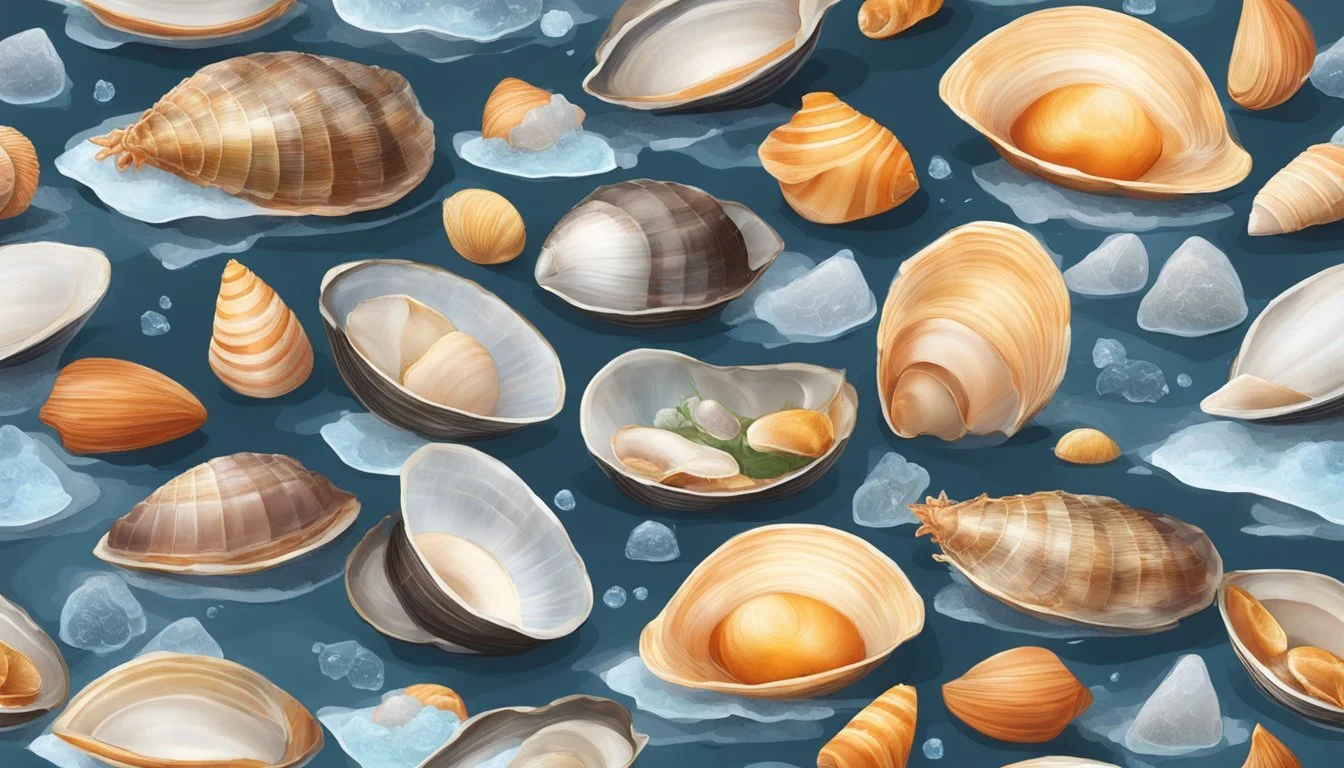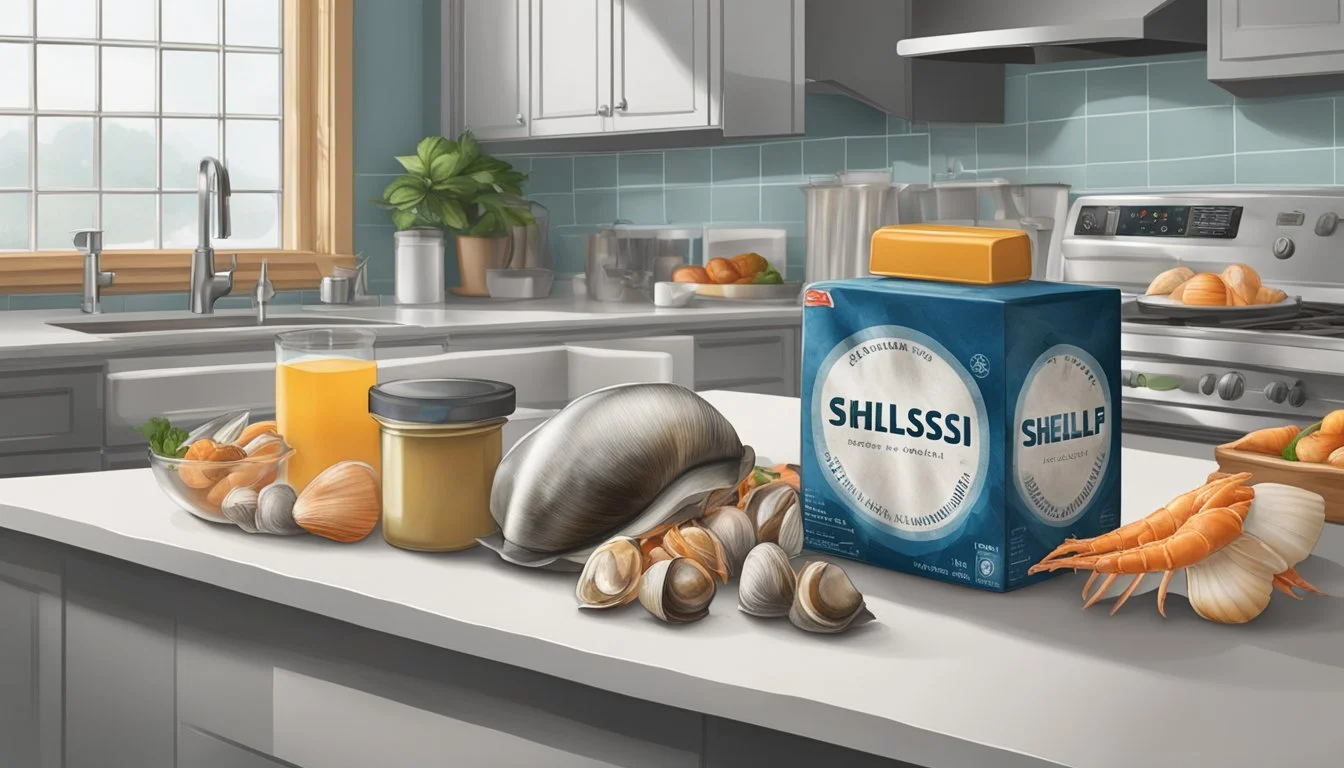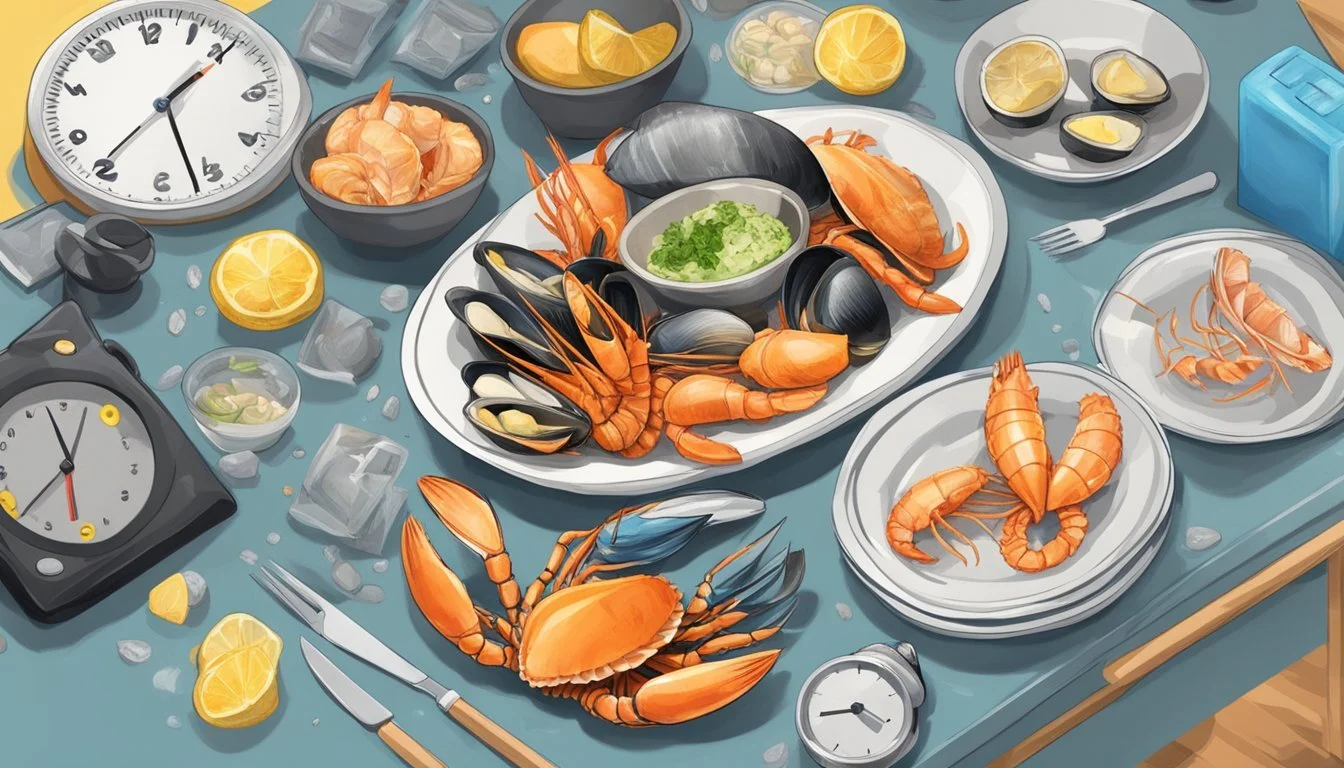How Long Does Shellfish Last?
Shelf Life and Storage Tips
Understanding the shelf life of shellfish (What wine goes well with shellfish?) is essential for ensuring the safety and quality of seafood. Shellfish, which encompasses a variety of oceanic delicacies such as shrimp, crab (What wine goes well with crab?), lobster (What wine goes well with lobster?), and mussels, (What wine goes well with mussels?) play a vital role in many diets around the globe. They are a favored choice not only for their distinct flavors but also for their nutritious value. However, their perishable nature demands proper handling and prompt consumption.
Fresh shellfish should be consumed within a narrow timeframe; typically, raw fish or shellfish stored in the refrigerator is at its best when eaten within one to two days. For cooked shellfish, a slightly longer window of three to four days is considered safe. It is crucial to adhere to these guidelines, as the risk of foodborne illness increases with time due to bacterial growth.
For those who wish to extend the culinary enjoyment of shellfish, freezing offers an alternative. Frozen shellfish, when stored properly at 0°F (-17.8°C) or lower, can significantly prolong its usability. While the safety of the shellfish can be indefinite under these conditions, the optimal sensory qualities like flavor and texture are best preserved for three up to twelve months, depending on the type of shellfish. It's imperative to note that the storage method and the temperature consistency of the refrigerator or freezer play pivotal roles in maintaining the integrity of seafood.
Understanding Shellfish
Shellfish are a diverse group of aquatic animals regularly consumed worldwide, and they play a significant role in various cuisines due to their unique flavors and textures. Each type offers distinct nutritional profiles that contribute beneficially to a balanced diet.
Types of Shellfish
Mollusks: This category includes clams (What wine goes well with clams?), oysters (What wine goes well with oysters?), scallops (What wine goes well with scallops?), mussels, squid, octopus, snails, and abalone. They are generally characterized by a shell, though squid and octopus are notable exceptions.
Clams – Bivalves often found buried in sand.
Oysters – Renowned for their pearls and complex flavor.
Scallops – Valued for their delicate, sweet meat.
Mussels – Enclosed in dark, elongated shells.
Squid and Octopus – Shell-less mollusks with a distinctive chewy texture.
Snails and Abalone – More commonly used in specialized dishes.
Crustaceans: This group consists of shrimp, crab, and lobster. These shellfish are encased in a thicker exoskeleton and are often a centerpiece in gastronomy due to their rich and savory meat.
Shrimp – Small, widespread, and versatile in cooking.
Crab – Known for their sweet, flaky meat encased in a significant shell.
Lobster – Renowned as a luxury food with tender, rich meat.
Nutritional Value
Shellfish are not only sought after for their taste but also for their nutritional content. They are typically considered:
Low in fat: Shellfish generally possess lower fat content.
High in protein: They provide a high-quality source of protein.
Rich in vitamins and minerals: Shellfish can be an excellent source of zinc, iodine, B-vitamins (especially B12), and omega-3 fatty acids, which are essential for heart health.
Concerns: Some individuals may be allergic to shellfish, and it is crucial to be aware of potential mercury content, especially in larger fish species.
Shellfish can be a valuable addition to one's diet when sourced responsibly and prepared with food safety in mind.
Shellfish Storage
Proper storage of shellfish is critical for maintaining safety and quality. Specific temperature guidelines must be adhered to, and there are distinct methods for refrigeration and freezing that help preserve shellfish adequately.
Refrigerating Shellfish
One must store shellfish in the refrigerator at a stable temperature of 37°F to ensure their quality and safety. It is vital to place fresh shellfish in an open container, covered with a damp towel to maintain necessary humidity levels. They should never be stored in water as this can cause them to perish due to changes in the water's composition from their natural habitat.
Sniff shellfish; they should have a fresh, seawater scent.
Look for any signs of discoloration or unusual textures.
Time limits for refrigerated shellfish:
Raw: Typically 1 to 2 days.
Cooked: Generally 3 to 4 days.
Freezing Shellfish
When freezing shellfish, one must ensure they are frozen at 0°F or lower to keep indefinitely, although the best quality is maintained when they are used within specific time frames. It's important to note that while safe to eat, the flavor and texture may deteriorate over time.
Cooked fish: up to 3 months.
Raw fish: between 3 to 8 months.
Shellfish: between 3 to 12 months.
To freeze shellfish:
Prepare the shellfish: Ensure they are cleaned and prepare them as intended for later use before freezing.
Packaging: Wrap shellfish tightly, removing as much air as possible, or use airtight containers to prevent freezer burn.
Thawing: When ready to use, thaw frozen shellfish in the refrigerator, not at room temperature, to minimize the risk of bacterial growth.
Shelf Life of Shellfish
The shelf life of shellfish varies depending on whether it is stored fresh or cooked. It is vital for consumers to recognize the distinct storage timelines to maintain quality and ensure safety.
Fresh Shellfish
Fresh shellfish should be stored in the refrigerator and generally consumed within a short timeframe following purchase. Mussels and clams are best when used within 2-3 days. For optimal freshness, they should be placed in a bowl, covered with a layer of wet paper towels, and then set in a second bowl filled with ice. Oysters have a slightly longer refrigerator shelf life, remaining acceptable for consumption up to 7-10 days when stored correctly under cold, moist conditions.
Clams: Use within 2-3 days
Mussels: Use within 2-3 days
Oysters: Use within 7-10 days
Cooked Shellfish
Once shellfish is cooked, the window for consumption narrows. Cooked shellfish should be kept in the refrigerator and consumed within 3 to 4 days. The exact timeframe can slightly vary depending on the type of shellfish, but adhering to this general guideline safeguards against spoilage. It's essential to store them in airtight containers to retain quality and prevent contamination.
For extended storage, cooked shellfish can be frozen. When frozen at 0 °F / -17.8 °C or less, cooked shellfish maintain quality for up to 3 months before there are noticeable decreases in flavor and texture.
Refrigerated life: 3-4 days
Frozen life (cooked): Up to 3 months
Recognizing Spoilage
When it comes to shellfish, recognizing signs of spoilage is crucial for preventing foodborne illness. Fresh shellfish should not emit an overly fishy odor and must maintain their characteristic texture.
Signs of Bad Shellfish
Smell: A strong, putrid smell is a telltale sign that shellfish are no longer fresh.
Discoloration: Any abnormal coloration, such as black spots or milky residue, indicates spoilage.
Texture: The flesh should feel firm to the touch; if it's slimy or mushy, the shellfish are likely spoiled.
Taste: Consuming a small piece of cooked shellfish to check for an off-taste is risky and not recommended, as spoiled shellfish may carry harmful pathogens.
Risks of Eating Spoiled Shellfish
Food Poisoning Symptoms: Eating spoiled shellfish can lead to symptoms such as nausea, vomiting, diarrhea, abdominal pain, and stomach pain.
Severity: Symptoms can range from mild indigestion to severe, sometimes requiring medical attention.
Toxin Production: Certain spoiled shellfish can produce toxins that are not destroyed by cooking, posing a serious health risk if consumed.
Food Safety
Ensuring the safety of shellfish is critical to prevent foodborne illness. Proper food safety practices are essential to minimize the risks of cross-contamination and bacterial or viral infections.
Preventing Cross-Contamination
Cross-contamination occurs when bacteria or viruses are transferred from a contaminated object to shellfish. To prevent this:
Always use separate utensils for handling raw and cooked shellfish.
Surfaces that come into contact with raw shellfish should be thoroughly cleaned before being used for other foods.
Wash hands with soap and water for at least 20 seconds before and after handling shellfish.
Proper Handling Techniques
Shellfish safety extends to how they are handled and stored:
Shellfish should be stored in the refrigerator at 41ºF (5ºC) or below.
Cook shellfish to an internal temperature of 145ºF (63ºC) for 15 seconds to kill harmful bacteria and viruses.
After cooking, do not place shellfish on plates that previously held raw shellfish unless they have been properly sanitized.
Shellfish Allergies
Shellfish allergies are a serious concern for those affected, as they can trigger severe allergic reactions. Understanding the symptoms and management strategies is essential for safety and health.
Symptoms of Allergies
The immune system of individuals with shellfish allergies overreacts to proteins in shellfish, leading to the release of histamine and other chemicals that cause allergy symptoms. These symptoms can range from mild to potentially life-threatening. The most common symptoms include:
Hives or itchy skin
Swelling of the lips, tongue, or face
Trouble breathing or wheezing
Coughing, dizziness, or a hoarse voice
Stomach pain, vomiting, or diarrhea
Severe allergic reactions, known as anaphylaxis, may involve a sudden drop in blood pressure, loss of consciousness, or a weak pulse. Anaphylaxis can occur within minutes and requires immediate medical attention.
Managing Shellfish Allergy
Management of a shellfish allergy primarily involves the complete avoidance of shellfish, which includes both mollusks and crustaceans. Individuals should carefully read food labels and be aware of the potential for cross-contamination. Recommended management strategies include:
Carrying epinephrine auto-injectors for emergency use in case of anaphylaxis.
Taking antihistamine medications to alleviate milder allergy symptoms after consulting a healthcare provider.
Educating family and friends about the severity of shellfish allergies to prevent accidental exposure.
Consulting with an allergist for a proper diagnosis and personalized management plan, which may include tests to measure specific immunoglobulin E (IgE) antibodies.
If someone with a shellfish allergy experiences a severe allergic reaction, they should be transported to the emergency room immediately.
Health Implications
Consuming shellfish that has not been stored or prepared correctly can lead to serious health complications. It is paramount to recognize the signs of shellfish-related illnesses and understand the appropriate treatment methods.
Foodborne Illnesses Related to Shellfish
Shellfish can harbor dangerous toxins and pathogens that lead to foodborne illnesses. In particular, shellfish poisoning is caused when shellfish consume algae that produce harmful toxins, which can then accumulate in their flesh. Two forms of poisoning include:
Paralytic shellfish poisoning (PSP) occurs from toxins produced by microscopic algae in 'red tides'. Symptoms can appear minutes to hours after consumption, often starting with tingling or numbness around the lips, which can progress to difficulty breathing and potentially fatal paralysis.
Scombroid poisoning is not caused by the shellfish itself, but by the histamine that forms when certain fish, like tuna or mackerel, are improperly stored and begin to decay. Symptoms similar to allergic reactions, such as flushing of the face and difficulty breathing, may occur.
The consumption of tainted shellfish may also result in gastrointestinal distress, with common symptoms being vomiting, diarrhea, nausea, abdominal pain, and cramps. In severe cases, an individual may experience confusion and dizziness.
Treatment for Shellfish-Related Illness
Immediate treatment for shellfish-related illness often involves:
Hydration: Drinking plenty of water to replace fluids lost through vomiting and diarrhea.
Medications: Over-the-counter antihistamines may help to alleviate mild symptoms in case of an allergic-like reaction, while more severe reactions might require administration of epinephrine.
For cases of suspected shellfish poisoning, it is crucial that the affected individual seeks medical attention as soon as possible, as some symptoms can swiftly become life-threatening. Health professionals can provide supportive care and specific treatments depending on the type and severity of the poisoning.
Buying and Consumption
When purchasing shellfish, the emphasis should be on quality and safety, reflecting both the consumer's health and the enjoyment of the meal. Proper selection and responsible consumption at restaurants are paramount.
Selecting Quality Shellfish
Consumers should seek out fresh shellfish, ensuring they are alive before purchase if possible, particularly in the case of clams, oysters, and mussels. Signs of life include tightly closed shells or those that snap shut when tapped. It’s important to check for freshness indicators, such as a sea-fresh smell and moist, firm flesh. Purchasers need to be wary of any discolored spots or unpleasant odors. Shellfish should be stored in the coldest part of the refrigerator and consumed within 1 to 2 days for optimal freshness and safety.
Key considerations when buying:
Shell Condition: The shells should be free from cracks.
Smell: Fresh shellfish should have a briny, sea-like smell and not emit any pungent odors.
Appearance: Look for bright eyes and a shiny surface on items like prawns.
Eating Shellfish at Restaurants
Diners with food allergies should always inform restaurant staff of their condition, as shellfish allergies are common. When eating out, the quality of shellfish can be gauged by the restaurant's turnover and provenance of the seafood. High turnover often indicates fresher produce. If consuming cooked shellfish, one should ensure it is thoroughly cooked to decrease the risk of foodborne illnesses; opaque and firm textured is typically an indication of well-cooked shellfish.
At restaurants, consider:
Food Allergy Precautions: Alerting the staff promptly to any specific shellfish allergies.
Menu Indications: Dishes with shellfish should specify whether they include crabs, cockles, prawns, razor clams, or geoducks, allowing diners to make informed decisions.
Preparation Methods: Restaurants should be transparent about how their seafood is prepared and sourced.







